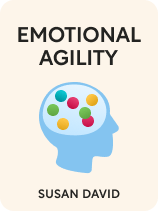

This article is an excerpt from the Shortform book guide to "Emotional Agility" by Susan David. Shortform has the world's best summaries and analyses of books you should be reading.
Like this article? Sign up for a free trial here.
How well do you understand your feelings? Do you know the context of your emotions?
Emotional agility is the ability to view events and emotions objectively and respond deliberately to them. According to clinical psychologist Susan David, emotional agility begins with a process of labeling your emotions.
Continue reading to understand the two key aspects of labeling your emotions and how to engage in this constructive practice.
Labeling Your Emotions
The first step to achieving emotional agility is labeling your emotions—that is, using honest, specific language to describe what you’re feeling. David argues that the combination of honesty and specificity forces you to understand the exact nature of your emotions, no matter how uncomfortable. Otherwise, you might feel tempted to ignore them or to use vague words to avoid painful vulnerability.
(Shortform note: While David focuses on the importance of fully understanding negative emotions, it’s also important to understand and engage with your positive emotions. Research suggests that doing so can improve your resilience to stress by helping you consider more creative solutions to problems in life—whereas negative emotions cause you to fixate on the issue at hand. For example, if you’re feeling apprehensive about major restructuring at your job, try changing your perspective by labeling the positive emotions you’re feeling: “I’m curious about what opportunities this will create, and I’m excited about the new skills I’ll learn.”)
For example, you might carry a decades-old burden of shame for never completing your education. You’ve previously talked about these feelings in a way that lacks specificity: “I wish I’d ‘done things differently’ in life.” Based on this generality, you think a career change will make you feel better—but this doesn’t address your feelings of shame and therefore doesn’t help. On the other hand, labeling your emotions precisely might mean saying, “For decades, I’ve regretted dropping out of college. I’ve felt shame for failing and wasting my parents’ money. Every day since then, I feel sick at the mention of school or career growth.”
(Shortform note: While labeling your emotions is the foundational step of developing emotional agility, some people have great difficulty doing so, due to alexithymia, or emotional blindness. While David seems to suggest that people with alexithymia can learn to label their emotions just like anyone else, alexithymia may be a more serious issue requiring professional help. Research suggests that alexithymia is a depression-like personality trait that may increase your risk of serious health concerns like substance abuse, self-harm, and suicidal behavior. While applying principles from ACT like labeling your emotions, self-compassion, and introspection can help, you should seek the help of a mental health professional if you think you suffer from alexithymia.)
| The Origins of Emotional Agility David first discussed emotional agility in a 2013 Harvard Business Review article. In the article, David explains that her emotional agility principles are derived from Acceptance and Commitment Therapy (ACT). The ACT model’s principles are meant to help patients view their thoughts objectively, be more self-aware, and set goals based on their values. ACT was developed in the late 1980s by Dr. Steven C. Hayes and his colleagues, and it’s been taught by many mental health professionals since. For decades, Hayes and others have referred to the practice of ACT’s principles as “psychological flexibility.” David’s term “emotional agility” is perhaps more approachable, reminding you to be wary of how your emotions control you—instead of having the academic connotations of the word “psychology.” Similarly, her use of “agility” may remind you to act deliberately, while “flexibility” might suggest a more passive reaction to your emotions. In 2020, Hayes published A Liberated Mind, which takes a deep, technical approach to ideas similar to those of Emotional Agility. After familiarizing yourself with ACT’s principles in Emotional Agility, you might consider reading A Liberated Mind to gain a more academic perspective and learn about additional topics such as integrating ACT’s principles (which deal with the spiritual concept of the self as separate from the body, sensations, and emotions) with religion. |

———End of Preview———
Like what you just read? Read the rest of the world's best book summary and analysis of Susan David's "Emotional Agility" at Shortform.
Here's what you'll find in our full Emotional Agility summary:
- Why most people react instinctively rather than objectively
- How to live according to your values to create the life you want
- How to handle your emotions better using mindfulness techniques






